Protest Against Blair at Chilcot Inquiry
QEII Conference Centre, Westminster, London. Friday 29 Jan 2010
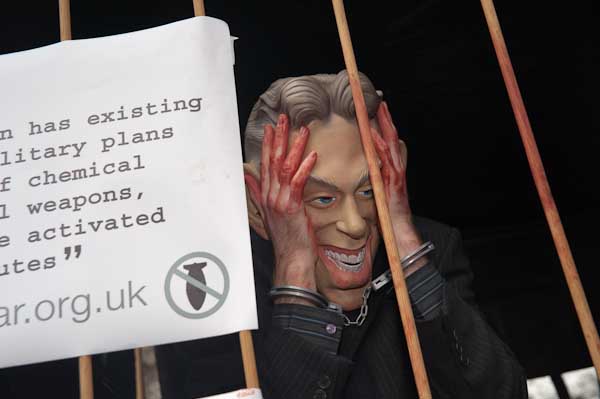
Blair continued to evade the truth in his evidence to Chilcot
more pictures
It was a long day for Tony Blair, who left home early in the morning to avoid
press and protesters, entering the QEII centre by a side entrance. Stop the
War and other groups had organised a daylong protest, starting at 8 am. When
I arrived late morning there were several hundred people outside the centre,
shouting for Blair to be arrested and tried for war crimes.
It was a damp and freezing day, and many of those who came to protest stayed
only for an hour or two, but others took their place through the day, and
by the time Blair was due to leave there were crowds around the various exits,
held back by large numbers of police.
There were various speeches and other performances during the day, but it
was the lunchtime appearance of some members of the military families that
provided the most dramatic moments. They had been inside the inquiry listening
to Blair and were appalled at both his evidence and the lack of critical questioning
from the inquiry members. Theresea Evans, proudly wearing her late
son's medals, spoke of Blair's complete failure to make any apology for the
effects of his decision, and her disgust at his smirking while giving evidence.
Maxine Gentle who was 14 when her brother Gordon was killed in Iraq
in 2004 read the letter she wrote then to Blair, and her words then remain
a moving expression of what many military families feel:
"My feelings are that I think you are rubbish at your job. You don't
care about the British public, armed forces or anyone.
My big brother died at the age of 18, and what for? A war over oil and
money. I think that you should withdraw all of our soldiers from Iraq. After
all, it's not our war, it's America's.
We are all hurting badly, but I don't just blame Gordon's death on the
Iraqis that made the roadside bomb. I blame YOU as well, because it is your
fault that our soldiers are over there in the first place."
The families had hoped for some expression of real regret from Blair but
instead got a great deal of self-justification and the feeling he had learnt
no lessons but would be happy to make a similar tragic mistake over Iran were
he still in power.
At 5pm, when Blair was thought to be about to leave, the samba band led a
group of demonstrators on a short march into Parliament Square and around
to the road at the back of the centre, blocking it for a short time before
they were cleared by a large number of police. An hour later, there were still
large groups of protesters and press at all exits waiting for him to emerge.
It appears that he was smuggled out by some unknown exit, perhaps through
a neighbouring building or one of the underground tunnels in the area to avoid
them.
more pictures
Life Is Too Short to be Controlled
St Pancras to Piccadilly Circus, London. Saturday 23 Jan, 2010
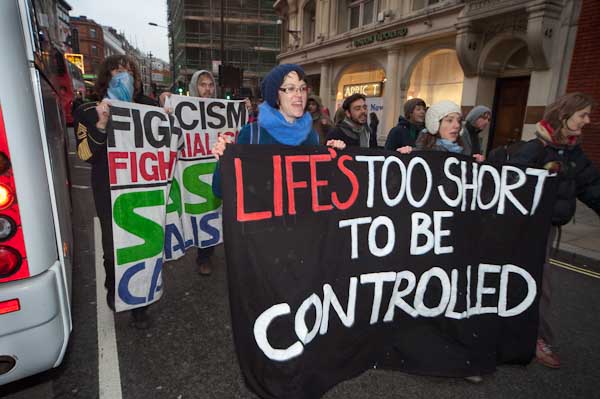
After a rally at St Pancras, over 150 marched to Piccadilly
Circus
more pictures
'Life is too short to be controlled' was a protest in London on
Saturday against the increasing control over our lives through increased police
powers to stop and search, increased surveillance and controls on freedom
of movement. Over 150 people took part in a march, organised by 'London
NoBorders', from St Pancras where the Border Authority detains migrants
arriving by Eurostar to Piccadilly Circus where Westminster's CCTV HQ keeps
a watch on you on streets across London.
The event started with a rally outside St Pancras, with speeches from people
representing various groups concerned with migration issues. One of the speakers
was a young man who had stayed in the 'jungle' at Calais and had since managed
to get to the UK. He spoke of the dangers he and his fellow travellers had
endured hiding on a refrigerated lorry to get across the channel.
Although there were two police vans parked a few yards away, they stayed
away from the protest, with a solitary officer watching from some distance.
Many of the protesters were wearing attractive pale blue scarves over the
lower half of their faces produced for the event, reminding them to smile
for the CCTV cameras. They formed up to march through London, starting off
along the busy Euston Road. Surprisingly not a single police officer appeared
as they marched along busy streets, stopping the traffic for a few minutes
as they passed through.
Led by banners 'Life's too short to be controlled' and 'Freedom
to Move, Freedom to Stay', there were also other flags and banners, including
someone with the message 'Don't border me' and two red flags, one
with the message 'We're rude weird We are Forainer' and the other with a simple
large '89', perhaps a reference to the year which saw the breakup
of the Soviet bloc. More direct was the message from 'Fight Racism Fight
Imperialism, 'Smash Capitalism.'
It was a very well-ordered march, and when an ambulance answering an emergency
came along, the whole march cleared the road for it with remarkable speed.
At Russell Square, one taxi driver decided to try to force his way through
the marchers, but was soon stopped, with several people sitting on the bonnet
of his vehicle. Otherwise most people seemed to take the slight delay to their
progress well, some taking the leaflets offered to them and expressing support.
Arriving at Picadilly Circus, the marchers blocked the road for a token five
minutes or so before going on to the pavement beside the statue of Eros, where
there were some more speeches and some dancing to the bike-powered sound system.
Still no police appeared for some time, but a couple of minutes after one
of the protesters had climbed up and taped a Palestinian flag to Eros's bow,
a Police Community Support Officer appeared. He made an effort to identify
the person concerned but soon gave up and went away. A few minutes later a
single police officer arrived, to be greeeted with hugs. Somewhat embarrased,
he stood a few yards away and watched the protest. Talking to another photographer
he confirmed that the police had monitored the progress of the march across
London.
St Pancras has detention holding facilities for migrants arriving on the
Eurostar, and this country has the largest compled of immigration detention
centres in Europe, jailing 2500 people including children at any one time,
with plans to increase the capacity to hold 4500 shortly.
London, the "City of CCTV" has over 500,000 CCTV cameras
watching us, installed by councils, public bodies, companies and individuals
- there are around 4.2 million in the whole of the UK. On a typical day the
average person in London will be recorded by 300 of them.
more pictures
I'm A Photographer Not A Terrorist
Tragalgar Square, London. Saturday 23 Jan, 2010
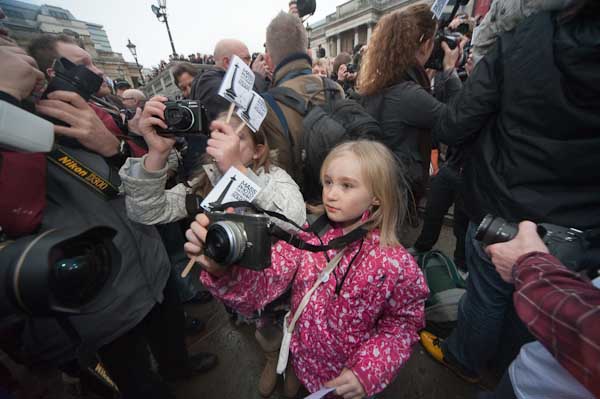
Two of the younger photographers among the several thousand present
more pictures
Around 2000 photographers gathered in Trafalgar Square, London today to protest
at the harassment of people taking photographs by police, and in particular
their abuse of powers under the Terrorism Act.
Increasingly both professional photographers working on the streets and amateurs
taking pictures have been approached by police, questioned and then subjected
to a search, usually under Section 44 of the Terrorism Act 2000 (S44.)
These stop and searches appear to have continued unabated despite a Home
Office Circular in September that made it clear they should not be used to
target photographers. Searches can also be carried out under Section 43 of
the act, but for this officers must have reasonable grounds to suspect someone
of being a terrorist. S44 stops can only be carried out in "authorised
areas", which although intended by Parliament to apply in very restricted
areas for short lengths of time have been used by police - for example - to
permanently to cover central London and some other areas.
Working photojournalists continue to be searched even though they may show
a Press card that states on it "The Association of Chief Police Officers
of England Wales and Northern Ireland and the Association of Chief Police
Officers in Scotland recognise the holder of this card as a bona-fide newsgatherer."
One of my colleagues who carries such a card was the subject of roughly 30
searches in 2009. It is hard not to reach the conclusion that at least at
times the police have used S44 as a way of harassing photographers.
The government is currently preparing an appeal against a European Court
Human Rights ruling that the stops and searches conducted under Section 44
are a breach of human rights and thus illegal.
A BBC News reporter, standing in the middle of a crowd of experienced journalists
used to recording large events was howled down after giving a report in which
he gave the number attending the protest as "three hundred." Clearly
there were well over a thousand taking part - my own estimate was around 1500,
although I heard larger figures given. It was not a good advertisement for
the competence or impartiality of the BBC who appear to have a policy of playing
down dissent; their reported numbers for other events I have attended have
also at times been laughably low.
As well as perhaps two thousand people of all ages taking pictures, the event
was also enlivened by several pieces of street theatre, including the Vigilance
Committee with a man on stilts wearing a number of CCTV cameras accompanied
by a male and female vigilance officer, who picked on individuals and questioned
them, taking their fingerprints before finding them guilty and sentencing
them to a choice of six years hard labour or contributing to the Vigilance
Committee. Three Sisters of Perpetual Indulgence also came along and added
a little colour (or pallor) to the event.
As for the police themselves, and the "heritage wardens" who usually
patrol the square (and at times tell people they are not allowed to take photographs)
they werevery little in evidence today, although some photographers managed
to photograph them. Doubtless they were keeping an eye on the event through
CCTV. The event organisers had not applied for permission to hold the event
and it would have been illegal, but apparently the authorities had put in
an application on their behalf without informing them.
more pictures
Brighton Smash Edo Remember Gaza
Brighton. Monday 18 Jan, 2010
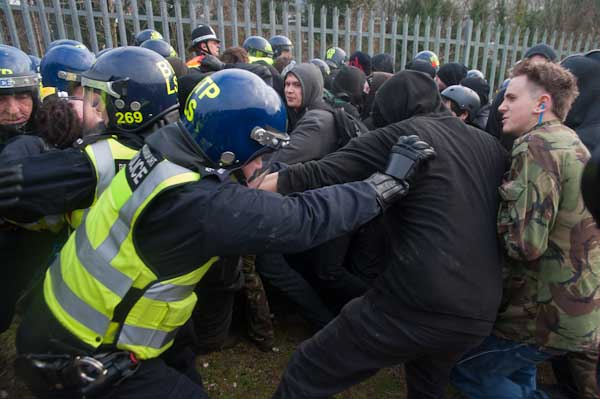
Police push back protesters trying to reach the EDO weapons factory
more pictures
On the first anniversary of the end of the Israeli war against Gaza, Smash
EDO activists in Brighton organised a demonstration against arms manufacturer
EDO MBM/ITT who made some of the weapons that killed 1417 Palestinians, mainly
the elderly, women and children, during the three-week assault.
Around three hundred demonstrators mainly dressed in black as the organisers
suggested, assembled at 1pm in Moulscoomb Wild Park, a short walk from the
EDO factory. They intended to march up Home Farm Road for a demonstration
outside the factory. Demonstrators had been advised by the organisers to wear
masks at all times during the event as both police and press would be taking
photographs.
Police watched the build-up, with four mounted police and several officers
on foot on a ridge overlooking the meeting point, and others in the area around.
A couple of officers attempted to hand out notices explaining the police powers
under 'Section 14' of the Public Order Act, but few took one. These
orders allow police to impose conditions on demonstrations "to prevent
serious public disorder, serious criminal damage or serious disruption to
the life of the community" and they may set limits on the location,
duration and number of people allowed to take part.
Eventually the march moved off towards the EDO arms factory, but when the
reached the bottom of Home Farm Road they could see that there was a large
police presence blocking their intended route to prevent them demonstrating
outside the factory.
Most of the people on the march decided to run up the hill and into the woods
to try to reach the factory. I went with them, and as we neared the back of
the factory we were met by a small group of police with dogs who warned us
we would be bitten if we approached. The demonstrators turned away and walked
further through the wood and across an open space where they were met by a
line of police.
After a while the several hundred protesters decided to continue through
the line of police; a few officers made a half-hearted attempt to stop them
and were then told to allow them through, and they walked down beside a fence
at the rear of the factory to a footpath leading to the far end of Home Farm
Road. This meant that the factory was effectively surrounded by the demonstrators
and all entrances and exits blocked.
At this point they were stopped by another line of police, this time defending
a fairly narrow footpath. The demonstrators tried to push through but were
repelled and then scattered when the eight mounted police rode in. They regrouped
a few years back but as a number of police with riot shields arrived they
decided to go back the way they had come.
Halfway up the path at the back of the factory, people realised it was possible
to lift up the bottom of the wire fence and scramble under the bottom of it
into the factory site (actually the bakery next door to EDO.) I decided not
to follow them and could only photograph through a wire fence and some branches.
Around 20 had made their way through when police came to meet them with batons
drawn. The protesters rolled a few oil drums down towards them, but once police
with dogs arrived they quickly scrambled back under the fence onto the path.
By this time the police horses and riot police had followed the protesters
up the hill and there was a little shoving and fighting with at least one
protester needing attention from the protest medics after having a baton blow.
After a while the protesters were forced to move on and up to the top of the
hill, where the police formed a line to stop them going down again.
After a few minutes standing around, the protesters moved away and down through
the woods to join the smaller group of demonstrators and the sound system
who had waited at the bottom of Home Farm Road.
The protest then set out to march back to Brighton. About a quarter of a
mile down the road the police attempted to block off the road and stop the
march outside Brighton University, but people found a way around the police
line through a car park. The police repeated the attempt to stop the marchers
a number of times but without a great deal of success. At one point the police
announced that they were only stopping the march because there had been an
accident down the road that needed emergency vehicles to attend, and the marchers
did stop for a while.
As we got close to the centre of Brighton and the street was narrower the
police again stopped the march. The officer in charge said that he was not
going to allow them to continue to march through the city and disrupt shoppers
and people going home from work, and was imposing a Section 14 order to prevent
the marchers going beyond The Level, a nearby open space, where they could
stay for as long as they wished.
Eventually the police withdrew towards The Level, and the marchers then rushed
past them and the march continued across the centre of The Level and on into
town.
At this point I had to leave to catch a train home, and as I walked past
on my way to the station cordons of police appeared around KFC and McDonalds.
Later I heard these was a demonstration at a Barclays Bank and partying in
the streets, and four or five arrests were made, mainly for breaching the
Section 14 Order.
more pictures
Gaza Remembrance Die-In
Trafalgar Square, London. Saturday 16 Jan 2009
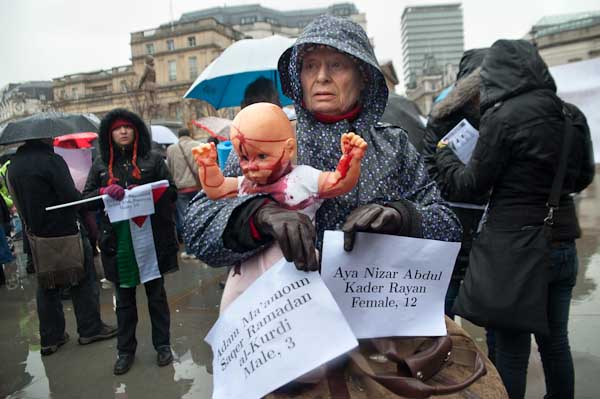
Many of the 1417 who died were children
more pictures
The Gaza Remembrance Die-In remembered the 1417 men, women and children killed
during the 22 days of Israeli attacks on Gaza a year ago. People held up sheets
with the names and ages of those who were killed, and despite the weather,
with spells of heavy rain, a few staged a die-in.
There were several speeches by Palestinians about what had happened in Gaza
when it came under attack - including the Israeli use of illegal white phosphorus
weapons, as well as about the continuing refusal of the Israeli authorities
to let medical supplies, building materials and other much-needed supplies
into Gaza.
The speech that moved me most was by a woman holding a placard '15+1', reminding
us of the members of her own family who had been killed, both during the attacks
and in continued Israeli aggression since the cease-fire. She told us how
young children asked her if she could use magic to bring back their parents.
When I arrived in Trafalgar Square it was pouring down with rain and streams
of water were running across the square - enough to get my feet wet walking
through them. Although it had eased off by the time the event started - and
even more or less stopped for a few minutes - it was still too wet for the
planned die-in, when the organisers had hoped to have 1417 people - one for
each death - lying down on the pavement for around 15 minutes. The pouring
rain will have no doubt put some people off coming, and there were only several
hundred present in any case.
Instead of the die-in, there was a period of silence in which people held
up the sheets with the names and ages of those who had been killed. Looking
at these as I photographed them, there seemed to be a great many children
and the elderly.
At the end of the event a few hardy people did lie down on cardboard sheets
for photographs to be taken - while some of the younger people present staged
an anti-Zionist protest by burning some crudely drawn Israeli flags. They
see the persecution of Palestinians by Israel as and attempt to wipe out their
nation as the Nazis wanted to eliminate the Jewish people.
The Gaza 1417 Remembrance was organised by the International Solidarity Movement,
a Palestinian led movement of international volunteers and Palestinians based
in the occupied Palestinian territories who attempt by their peaceful presence
to reduce the violence towards Palestinians from the Israeli army and settlers.
ISM trains volunteers stay with Palestinian communities and act as witnesses
to the human rights abuses they suffer and to report truthfully on events
in Palestine to the outside world.
more pictures
Guantanamo Bay - 8 Shameful Years
US Embassy, Grosvenor Square, London. Monday 11 Jan 2010
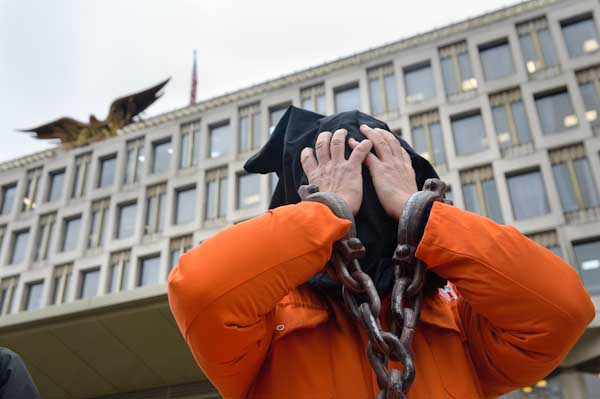
Almost 200 detainees are still held in Guantánmo
Bay
more pictures
The London Guantánamo Campaign held a demonstration on eighth anniversary
of Guantánamo Bay, Monday 11 January 2010, outside the US Embassy in
London. A vigil by protesters in orange jumpsuits and black hoods was followed
by an hour of speeches calling for the closing down of the camp without further
delay and justice for all those still detained there.
Although all British subjects have now been released from Guantánamo
Bay, there are still two men with British connections held there. Shaker Aamer
is a British resident, with a British family living in Battersea, London -
his four British children include a seven-year-old son he has never met. The
campaign also urges the UK government to press for the release of Algerian
asylum seeker Ahmed Belbacha, who was formerly living in Bournemouth, on humanitarian
grounds.
Although Obama pledged to close down the camp by Jan 22, 2010, this deadline
will not be met. US actions over the detainees have been clearly in breach
of international law since the start, and this and illegal prisons in other
countries which the USA has made use of have clearly damaged America's reputation
as well as radicalising many around the world to acts of terrorism.
Just fewer than 200 prisoners are now still held at Guantánamo Bay.
Of these around 50 have already been cleared for release but no suitable country
has yet been found for them to go. There may be sufficient evidence to try
around 25 on the US mainland, although since much of this evidence was obtained
using torture it is probably impossible for any to be convicted in a fair
trial.
It is not clear why the remaining 120 or so are still being held. One of
the speakers, journalist Andy Worthington, suggested that in Shaker Aamer's
case it may well simply be that his release would be too embarrassing for
the US government because of his extensive knowledge about what has gone on
at Guantánamo.
As well as pressing for the return of the two British residents from their
illegal detention, the UK government, along with other European governments
was also urged to give a home to some of the other detainees who are unable
to return to their home countries.
Nicky Jameson of Fight Racism Fight Imperialism reminded us that the whole
US presence at Guantánamo Bay is illegal, the US occupation of the
area coming from the 1903 Cuban-American Treaty, which was in violation of
international law as it was obtained by threat of force.
Other speakers shown in the pictures include Green MEP for London Jean Lambert
who has also submitted a parliamentary written question asking the European
Commission to clarify what steps have been taken by Member States to assist
in the closure of Guantánamo by agreeing to receive former detainees,
Chloe Davies of Reprieve, a legal charity which fights for human rights for
prisoners; already over 50 of their clients have been released from Guantánamo,
but they continue to represent over 30 still there, Lindsey German of Stop
the War, Joy Hurcombe of Brighton Against Guantánamo and John Clossick
of the Save Shaker Aamer Campaign.
more pictures
Drum For Peace in Sudan
Downing St, Whitehall, London. Saturday 9 Jan, 2010
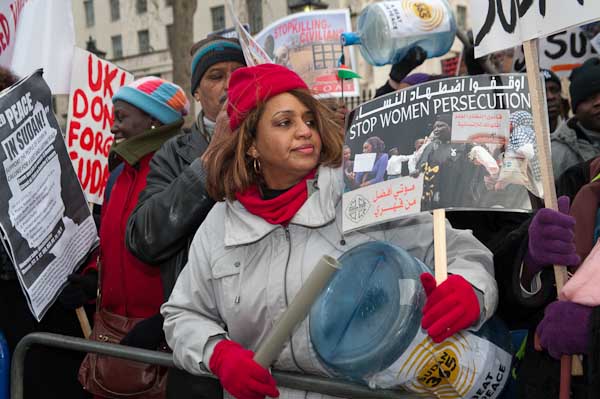
Several hundred demonstrators, including a large group fromthe Darfur community
in Coventry, turned up opposite Downing Street on a cold Saturday morning for
a couple of hours of noisy drumming. They called for peace, human rights and
development for all in all regions of Sudan, with safety and security for all,
as well as protection for Darfur, women's rights and the peace agreement, and
demanded that there be free and fair elections and referendum in the country.
They were then addressed by Sudanese Archbishop Daniel Deng, in
London for meetings with Prime Minister Gordon Brown and Archbishop Rowan
William on Monday.
Groups supporting this demontration were the Aegis Trust, Darfur Training
Committee, Darfur Union, Darfur Victims' Organisation for Rehabilitation and
Relief, Mothers For Peace, Nour Asamaa, Salisbury-Sudan Church Link, Sudan
Doctors' Union, Sudan In Action, Sudan Women's Association, Sudanese Women's
National Alliance in Diaspora, Sudanese Community and Information
Centre and Waging Peace and others.
It was a part of the launch of a global Sudan365 campaign by a coalition
of groups including the Aegis Trust, Amnesty International, Arab Coalition
for Darfur, Darfur Consortium, FIDH, Human Rights Watch, Refugees International
and the Save Darfur Coalition in the year leading up to the 2011 Sudanese
referendum early next January.
Exactly 5 years previously, on the 9th January 2005, a 'Comprehensive
Peace Agreement' (or CPA) was signed between the Sudanese government
and the opposition National Democratic Alliance, intended to bring
to an end the Second Sudanese Civil War between the government representing
the Muslim north of the country and other groups, particularly the largely
Christian south of the Sudan People's Liberation Movement (SPLM.)
Despite the settlement, many problems remain, particularly with the continued
fighting in Darfur where government forces are accused of genocide, and the
International Criminal Court issued the first ever arrest warrant for a sitting
head of state, Sudanese President Omar al-Bashir, charging him with war crimes
and crimes against humanity.
Part of the CPA called for a referendum to be held in Southern Sudan in January
2011 to allow the people there to decide whether to become independent or
remain in Sudan, along with a similar referendum or consultations in some
smaller areas of the country. Before the referendum there was to be a countrywide
census and registration of voters, and a national election in 2010. The census
has turned out to be very problematic because of the nomadic nature of much
of the population, the aftermath of the civil war and it particular its huge
numbers of refugees and the continuing conflict in Darfur. Lengthy negotiations
have finally led to the agreement that for the referendum to be valid it must
give at least a 51% majority on a turnout of 60%.
The Sudan365 campaign’s 'Drum for Peace' has attracted support
from some of the most famous drummers from around the world, including Phil
Selway of Radiohead, Stewart Copeland of The Police and Pink Floyd's Nick
Mason, who are taking part in a film in which the drum beat for peace, starting
in Sudan is passed to drummers around the world, including in Brazil, Mexico,
US (New York and San Francisco), UK, France, Spain, Senegal, South Africa,
Ghana, Egypt, Mali, UAE, Japan, Russia and Australia.
more pictures
Westminster on Saturday - Ice & Protest
Trafalgar Sq, Whitehall & Parliament Square, London. 9 Jan 2010
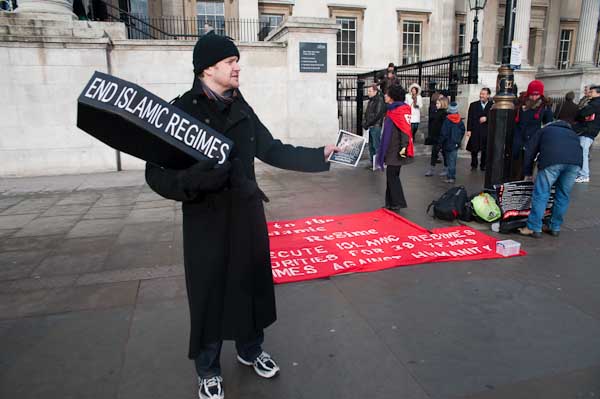
In Trafalgar Square, Iran Solidarity were calling for an end to Islamic regimes
more pictures
The snow and cold weather hasn't stopped London's protesters, though in a
still snow-covered Parliament Square they were keeping inside their tents.
As well as Brian Haw's peace protest, continuing since June 2001
there are also banners for the Peace Strike, which also supports
the Sri Lankan Tamils, and anothert large banner calling for a boycott of
Sri Lankan made garments and holidays in the country.
I walked back up Whitehall pat the government offices and the gathering
demonstration over Sudan (see above.) The former Colonial office is an imposing
reminder of the Victorian era when Britian ruled much of the world (and then
and later produced much of the mess it is now in.)
Although the pavements are clear of snow, the fountains in Trafalgar Square
have a thick topping of ice, although in places this had been broken around
the edges and people had thrown lumps of the ice across it. Several cans,
bottles and other rubbish, including a newspaper had been frozen in.
There were at least two groups of protesters on the North Terrace while I
was there. One was I think the regular Quaker vigil for peace in the Middle
East that has been held on the first Saturday of each month (though this was
the second Saturday) since May 1, 2004, but I didn't go across to take pictures
again. The other was the Iran Solidarity group who have organised daily acts
of solidarity in Trafalgar Square and in other cities since Monday July 27
2009, and intend to continue until June 20, 2010 when there will be a mass
demonstration on the anniversary of the killing of Neda Agha-Soltan.
more pictures
Thames Path
Reading to Cholsey. 1-2 Jan 2010
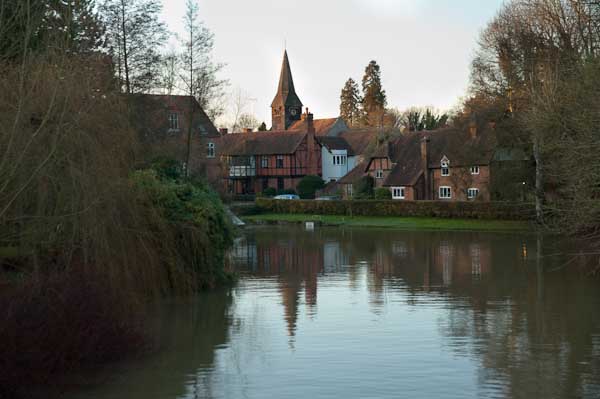
We walked from Reading to Pangbourne on New Year's Day
more pictures
New Year's Day was biting cold and the trains were running a Sunday service,
so we got to Reading a little later than expected. But from there on it was
easy walking, if cold. Our guide book, written perhaps 20 years ago, promised
us some riverside industry at Reading, but by now it has all been replaced
by some rather dreary flats.
The next few miles were hardly exciting, but at least the near freezing temperatures
meant that much of the mud was frozen. At Tilehurst the path is very close
to the railway embankment, at times just a few feet of path between it and
the river, and every few minutes a train hurtled past on what was the GWR
main line.
At Purley the path leaves the river and crosses the line by a footbridge
to a pub - which was closed for refurbishment. It's a shame there is such
a long detour here, waymarked through a large and boring housing estate to
get to the next bridge across the railway line and back through some playing
fields to the river at Mapledurham Lock. The developer of the estate built
several houses on the designated path, which should run trhough a tunnel under
the railway land and past the back of the marina to Purley Gardens and back
to the Thames there. It seems that at last a creation order is being sought
to allow the path to take its proper route, but for the moment it is a tedious
detour.
The section from Mapledurham to Pangbourne is more pleasant, although flooding
meant we had to make a detour about a quarter of a mile away from the Thames.
If you intend to walk the path, it is best not to wait until just after some
of the wettest months on record!
The highlight of Mapledurham Lock was that despite it being a Bank Holiday
the cafe was open and serving hot drinks. Very welcome, as this is possibly
the longest stretch of the Thames Path without a single pub open between Reading
and Pangbourne.
The following day we set off from Pangbourne and walked what must be the
most scenic few miles of the Thames path. The route starts off through the
frightfully picturesque village of Whitchurch, climbing up a hill and then
along a country road to nowhere. Then you walk down through woods to the river,
with some splendid views through the trees across the valley, part of which
is a wildlife park.
It's then a pleasant enough walk along by the river to the railway bridge
at Gatehampton, another of Brunel's impressive brick structures, built in
1838. Beyond it are the great treelined slopes of the Goring Gap, where the
river cut down thorugh the hills, dividing them into the Chilterns and the
Berkshire Downs and making it's way east to London.
From Goring we crossed the bridge to Streatley to continue our walk. The
path lead past the church and across a field to a gang-plank leading to the
centre of a small lake. Fortunately the path was just visible only a few inches
under water, and after watching a walker coming the other way we paddled on.
At Moulsford was John Outram's Egyptian House, completed around 2000, a welcome
change from the many other newer riverside homes we passed, which, mainly
seem designed to advertise the lack of taste of their owners. Then a diversion
takes the path away from the river and along the main road as the tow path
at this point crosses to South Stoke on the other bank. Where the path turned
back to the river around a mile on we continued and took a path just after
the railway bridge that led eventually to Cholford station.
more pictures - Reading - Pangbourne
more pictures - Pangbourne - Cholsey
top of page
All pictures on this section of the site are Copyright ©
Peter Marshall 2010; to buy prints or for permission to reproduce pictures
or to comment on this site, or for any other questions, contact
me.










